Analyzing Project Complexity: The Macondo Well Blowout Scenario
VerifiedAdded on 2023/06/04
|7
|1580
|354
Case Study
AI Summary
This case study analyzes the Macondo well blowout, a catastrophic event caused by operational failures and inadequate safety measures. The study examines factors contributing to project complexity, including organizational structure, risk management, and engineering risks. It highlights the importance of safety culture, proper decision-making, and effective risk mitigation strategies in preventing such disasters. The analysis draws from reports and investigations of the incident to provide insights into the failures in containment, control, and mitigation plans. The paper concludes that a robust system engineering approach, incorporating social knowledge, competency, and leadership, is crucial for successful project outcomes. This analysis is essential for understanding the complexities of projects in high-risk environments and for implementing better project management practices.
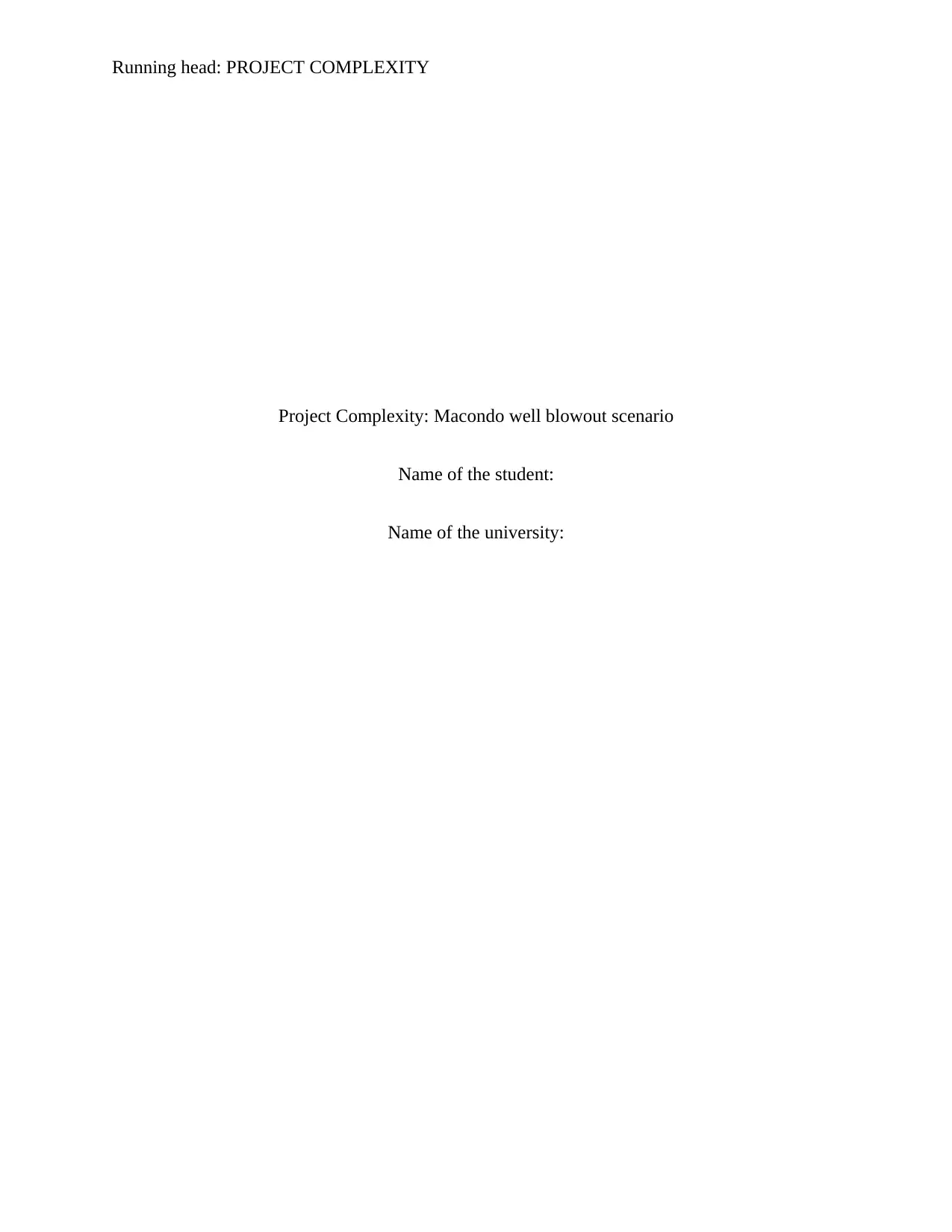
Running head: PROJECT COMPLEXITY
Project Complexity: Macondo well blowout scenario
Name of the student:
Name of the university:
Project Complexity: Macondo well blowout scenario
Name of the student:
Name of the university:
Paraphrase This Document
Need a fresh take? Get an instant paraphrase of this document with our AI Paraphraser
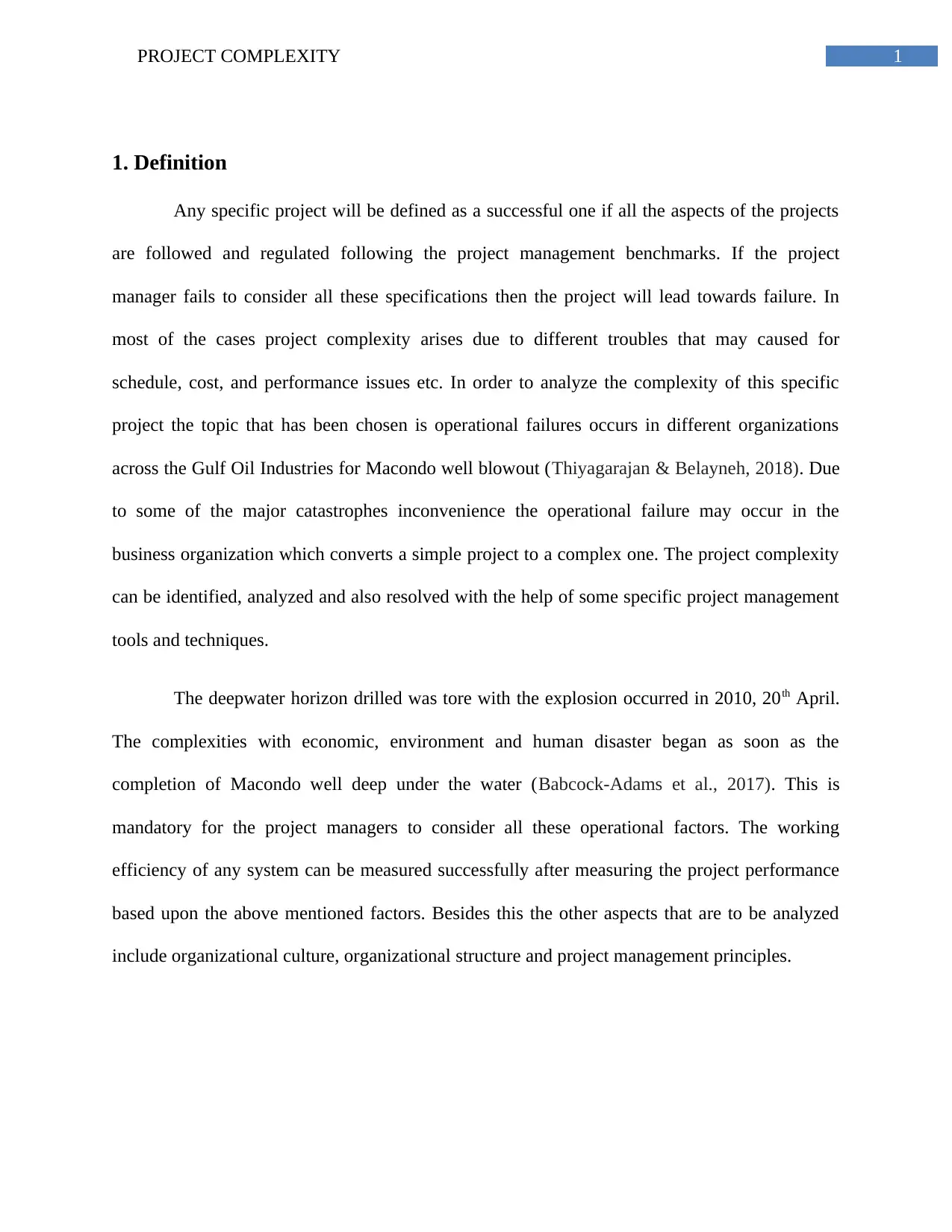
1PROJECT COMPLEXITY
1. Definition
Any specific project will be defined as a successful one if all the aspects of the projects
are followed and regulated following the project management benchmarks. If the project
manager fails to consider all these specifications then the project will lead towards failure. In
most of the cases project complexity arises due to different troubles that may caused for
schedule, cost, and performance issues etc. In order to analyze the complexity of this specific
project the topic that has been chosen is operational failures occurs in different organizations
across the Gulf Oil Industries for Macondo well blowout (Thiyagarajan & Belayneh, 2018). Due
to some of the major catastrophes inconvenience the operational failure may occur in the
business organization which converts a simple project to a complex one. The project complexity
can be identified, analyzed and also resolved with the help of some specific project management
tools and techniques.
The deepwater horizon drilled was tore with the explosion occurred in 2010, 20th April.
The complexities with economic, environment and human disaster began as soon as the
completion of Macondo well deep under the water (Babcock-Adams et al., 2017). This is
mandatory for the project managers to consider all these operational factors. The working
efficiency of any system can be measured successfully after measuring the project performance
based upon the above mentioned factors. Besides this the other aspects that are to be analyzed
include organizational culture, organizational structure and project management principles.
1. Definition
Any specific project will be defined as a successful one if all the aspects of the projects
are followed and regulated following the project management benchmarks. If the project
manager fails to consider all these specifications then the project will lead towards failure. In
most of the cases project complexity arises due to different troubles that may caused for
schedule, cost, and performance issues etc. In order to analyze the complexity of this specific
project the topic that has been chosen is operational failures occurs in different organizations
across the Gulf Oil Industries for Macondo well blowout (Thiyagarajan & Belayneh, 2018). Due
to some of the major catastrophes inconvenience the operational failure may occur in the
business organization which converts a simple project to a complex one. The project complexity
can be identified, analyzed and also resolved with the help of some specific project management
tools and techniques.
The deepwater horizon drilled was tore with the explosion occurred in 2010, 20th April.
The complexities with economic, environment and human disaster began as soon as the
completion of Macondo well deep under the water (Babcock-Adams et al., 2017). This is
mandatory for the project managers to consider all these operational factors. The working
efficiency of any system can be measured successfully after measuring the project performance
based upon the above mentioned factors. Besides this the other aspects that are to be analyzed
include organizational culture, organizational structure and project management principles.
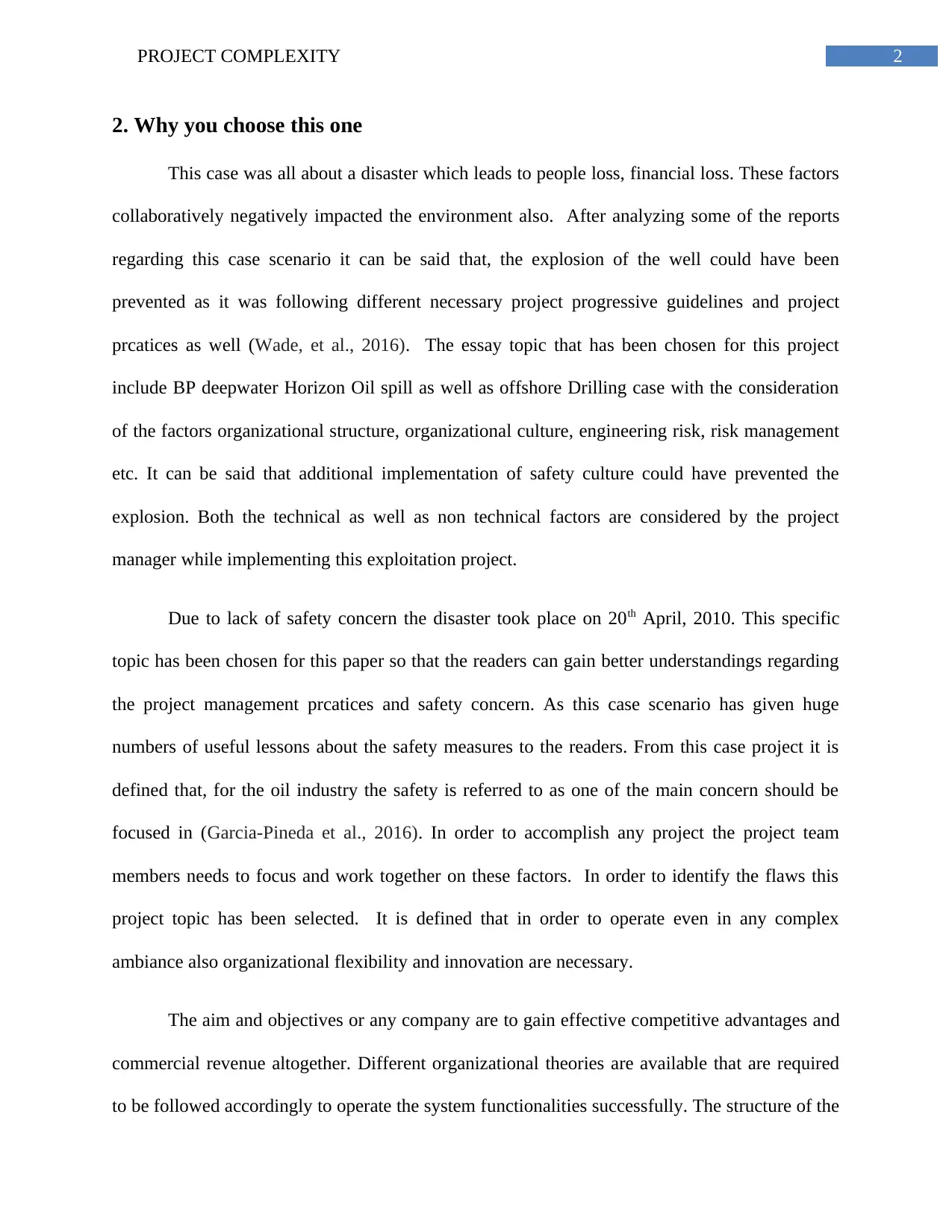
2PROJECT COMPLEXITY
2. Why you choose this one
This case was all about a disaster which leads to people loss, financial loss. These factors
collaboratively negatively impacted the environment also. After analyzing some of the reports
regarding this case scenario it can be said that, the explosion of the well could have been
prevented as it was following different necessary project progressive guidelines and project
prcatices as well (Wade, et al., 2016). The essay topic that has been chosen for this project
include BP deepwater Horizon Oil spill as well as offshore Drilling case with the consideration
of the factors organizational structure, organizational culture, engineering risk, risk management
etc. It can be said that additional implementation of safety culture could have prevented the
explosion. Both the technical as well as non technical factors are considered by the project
manager while implementing this exploitation project.
Due to lack of safety concern the disaster took place on 20th April, 2010. This specific
topic has been chosen for this paper so that the readers can gain better understandings regarding
the project management prcatices and safety concern. As this case scenario has given huge
numbers of useful lessons about the safety measures to the readers. From this case project it is
defined that, for the oil industry the safety is referred to as one of the main concern should be
focused in (Garcia-Pineda et al., 2016). In order to accomplish any project the project team
members needs to focus and work together on these factors. In order to identify the flaws this
project topic has been selected. It is defined that in order to operate even in any complex
ambiance also organizational flexibility and innovation are necessary.
The aim and objectives or any company are to gain effective competitive advantages and
commercial revenue altogether. Different organizational theories are available that are required
to be followed accordingly to operate the system functionalities successfully. The structure of the
2. Why you choose this one
This case was all about a disaster which leads to people loss, financial loss. These factors
collaboratively negatively impacted the environment also. After analyzing some of the reports
regarding this case scenario it can be said that, the explosion of the well could have been
prevented as it was following different necessary project progressive guidelines and project
prcatices as well (Wade, et al., 2016). The essay topic that has been chosen for this project
include BP deepwater Horizon Oil spill as well as offshore Drilling case with the consideration
of the factors organizational structure, organizational culture, engineering risk, risk management
etc. It can be said that additional implementation of safety culture could have prevented the
explosion. Both the technical as well as non technical factors are considered by the project
manager while implementing this exploitation project.
Due to lack of safety concern the disaster took place on 20th April, 2010. This specific
topic has been chosen for this paper so that the readers can gain better understandings regarding
the project management prcatices and safety concern. As this case scenario has given huge
numbers of useful lessons about the safety measures to the readers. From this case project it is
defined that, for the oil industry the safety is referred to as one of the main concern should be
focused in (Garcia-Pineda et al., 2016). In order to accomplish any project the project team
members needs to focus and work together on these factors. In order to identify the flaws this
project topic has been selected. It is defined that in order to operate even in any complex
ambiance also organizational flexibility and innovation are necessary.
The aim and objectives or any company are to gain effective competitive advantages and
commercial revenue altogether. Different organizational theories are available that are required
to be followed accordingly to operate the system functionalities successfully. The structure of the
⊘ This is a preview!⊘
Do you want full access?
Subscribe today to unlock all pages.

Trusted by 1+ million students worldwide

3PROJECT COMPLEXITY
gas mug separator is also organized and implemented well in this case scenario. Not only his but
also how the hydrocarbon can enter the riser are also elaborated in this scenario. The reasons for
which continuous ends of well activities are taking place and also detracting the rig crew from
monitoring the project progress are illustrated in this project. It is defined that the system
operation is creating negative pressure for the operation. Excess flow of oil through the pipelines
caused pressure to the pipelines (Mason, 2017). How the hydrostatic pressure can under-status
are also illustrated in this scenario. During the testing phase, none of the steps for remedy has
been recognized for this project which is another reason for the explosion. These are the reasons
for which this specific topic has been chosen.
3. Why you did not choose another one
From the analytical resultants different evidence are generated for this specific topic.
Therefore for this topic it will be easier for the readers to understand the reason behind the
accident. The evidence shows that the failures were occurred due to inaccurate measures in
contain, control, clean up and mitigation plans (Babcock-Adams et al., 2017). The standards of
project management prcatices that may give further success to the project can be easily obtained
with the analysis of this case. Apart from this, due to lack of protection mechanism the project
has failed to meet the project objectives.
Proper organizational decision making, failure signal analysis and managerial processes
can how effectively help the project manager to meet the project objectives are easily obtained
from the case scenario (Paterson, 2016). The ways through which relationship between the cost
cutting and the risk taking are complimentary to each other are also gained from the analytical
gas mug separator is also organized and implemented well in this case scenario. Not only his but
also how the hydrocarbon can enter the riser are also elaborated in this scenario. The reasons for
which continuous ends of well activities are taking place and also detracting the rig crew from
monitoring the project progress are illustrated in this project. It is defined that the system
operation is creating negative pressure for the operation. Excess flow of oil through the pipelines
caused pressure to the pipelines (Mason, 2017). How the hydrostatic pressure can under-status
are also illustrated in this scenario. During the testing phase, none of the steps for remedy has
been recognized for this project which is another reason for the explosion. These are the reasons
for which this specific topic has been chosen.
3. Why you did not choose another one
From the analytical resultants different evidence are generated for this specific topic.
Therefore for this topic it will be easier for the readers to understand the reason behind the
accident. The evidence shows that the failures were occurred due to inaccurate measures in
contain, control, clean up and mitigation plans (Babcock-Adams et al., 2017). The standards of
project management prcatices that may give further success to the project can be easily obtained
with the analysis of this case. Apart from this, due to lack of protection mechanism the project
has failed to meet the project objectives.
Proper organizational decision making, failure signal analysis and managerial processes
can how effectively help the project manager to meet the project objectives are easily obtained
from the case scenario (Paterson, 2016). The ways through which relationship between the cost
cutting and the risk taking are complimentary to each other are also gained from the analytical
Paraphrase This Document
Need a fresh take? Get an instant paraphrase of this document with our AI Paraphraser
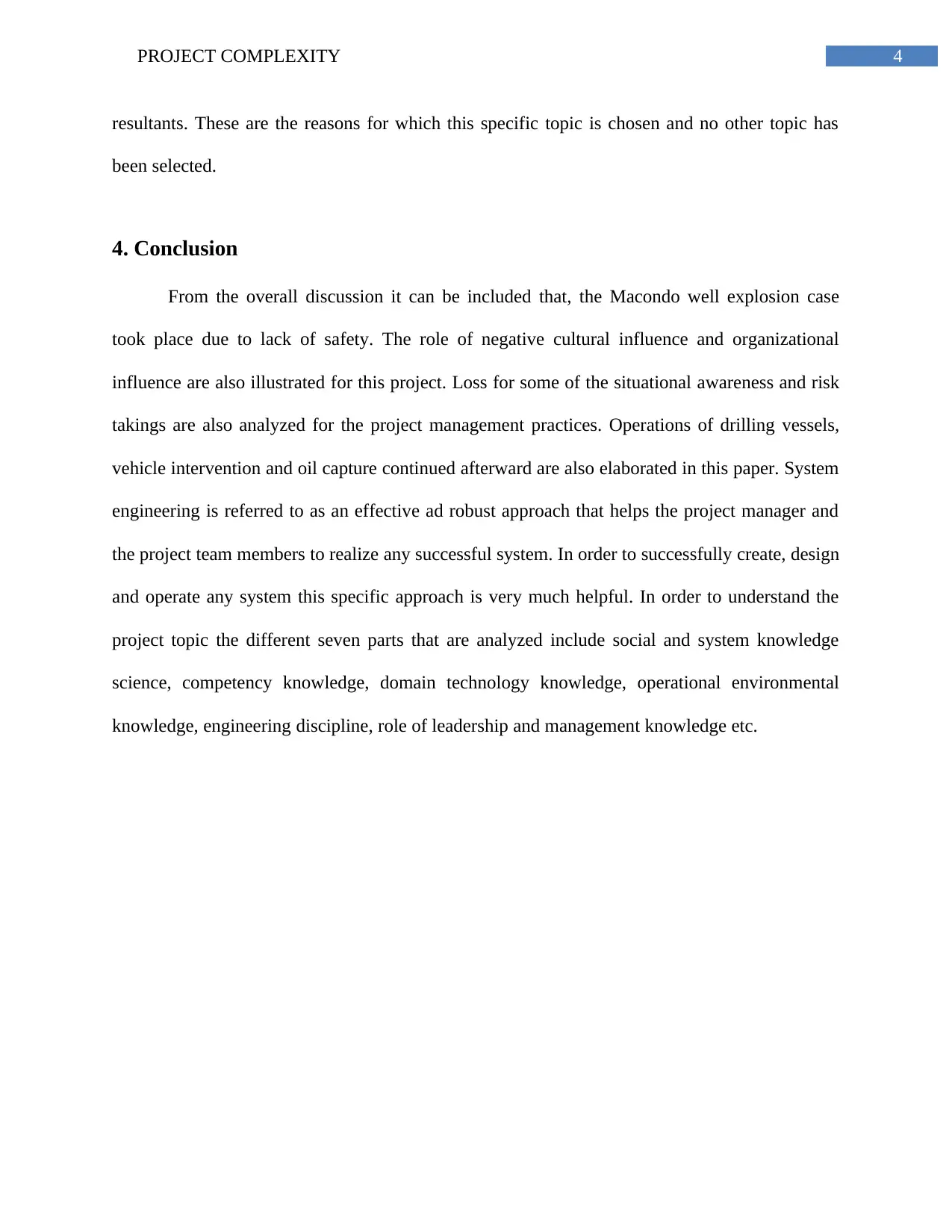
4PROJECT COMPLEXITY
resultants. These are the reasons for which this specific topic is chosen and no other topic has
been selected.
4. Conclusion
From the overall discussion it can be included that, the Macondo well explosion case
took place due to lack of safety. The role of negative cultural influence and organizational
influence are also illustrated for this project. Loss for some of the situational awareness and risk
takings are also analyzed for the project management practices. Operations of drilling vessels,
vehicle intervention and oil capture continued afterward are also elaborated in this paper. System
engineering is referred to as an effective ad robust approach that helps the project manager and
the project team members to realize any successful system. In order to successfully create, design
and operate any system this specific approach is very much helpful. In order to understand the
project topic the different seven parts that are analyzed include social and system knowledge
science, competency knowledge, domain technology knowledge, operational environmental
knowledge, engineering discipline, role of leadership and management knowledge etc.
resultants. These are the reasons for which this specific topic is chosen and no other topic has
been selected.
4. Conclusion
From the overall discussion it can be included that, the Macondo well explosion case
took place due to lack of safety. The role of negative cultural influence and organizational
influence are also illustrated for this project. Loss for some of the situational awareness and risk
takings are also analyzed for the project management practices. Operations of drilling vessels,
vehicle intervention and oil capture continued afterward are also elaborated in this paper. System
engineering is referred to as an effective ad robust approach that helps the project manager and
the project team members to realize any successful system. In order to successfully create, design
and operate any system this specific approach is very much helpful. In order to understand the
project topic the different seven parts that are analyzed include social and system knowledge
science, competency knowledge, domain technology knowledge, operational environmental
knowledge, engineering discipline, role of leadership and management knowledge etc.

5PROJECT COMPLEXITY
References
Babcock-Adams, L., Chanton, J. P., Joye, S. B., & Medeiros, P. M. (2017). Hydrocarbon
composition and concentrations in the Gulf of Mexico sediments in the 3 years following
the Macondo well blowout. Environmental pollution, 229, 329-338.
Garcia-Pineda, O., MacDonald, I., Silva, M., Shedd, W., Asl, S. D., & Schumaker, B. (2016).
Transience and persistence of natural hydrocarbon seepage in Mississippi Canyon, Gulf
of Mexico. Deep Sea Research Part II: Topical Studies in Oceanography, 129, 119-129.
Joye, S. B., Bracco, A., Özgökmen, T. M., Chanton, J. P., Grosell, M., MacDonald, I. R., ... &
Passow, U. (2016). The Gulf of Mexico ecosystem, six years after the Macondo oil well
blowout. Deep Sea Research Part II: Topical Studies in Oceanography, 129, 4-19.
Mason, C. F. (2017). Public Policy Towards Offshore Oil Spills. Oil flowed from the well into
the Gulf of Mexico for, 87.
Paterson, J. (2016). Health, Safety and Environmental Regulation on theUnited Kingdom
Continental Shelf in the Aftermathof the Macondo Disaster. LSU Journal of Energy Law
and Resources, 4(2), 7.
Tabibzadeh, M., & Meshkati, N. (2015, April). Applying the AcciMap Methodology to
Investigate a Major Accident in Offshore Drilling: A Systematic Risk Management
Framework for Oil and Gas Industry. In SPE Western Regional Meeting. Society of
Petroleum Engineers.
References
Babcock-Adams, L., Chanton, J. P., Joye, S. B., & Medeiros, P. M. (2017). Hydrocarbon
composition and concentrations in the Gulf of Mexico sediments in the 3 years following
the Macondo well blowout. Environmental pollution, 229, 329-338.
Garcia-Pineda, O., MacDonald, I., Silva, M., Shedd, W., Asl, S. D., & Schumaker, B. (2016).
Transience and persistence of natural hydrocarbon seepage in Mississippi Canyon, Gulf
of Mexico. Deep Sea Research Part II: Topical Studies in Oceanography, 129, 119-129.
Joye, S. B., Bracco, A., Özgökmen, T. M., Chanton, J. P., Grosell, M., MacDonald, I. R., ... &
Passow, U. (2016). The Gulf of Mexico ecosystem, six years after the Macondo oil well
blowout. Deep Sea Research Part II: Topical Studies in Oceanography, 129, 4-19.
Mason, C. F. (2017). Public Policy Towards Offshore Oil Spills. Oil flowed from the well into
the Gulf of Mexico for, 87.
Paterson, J. (2016). Health, Safety and Environmental Regulation on theUnited Kingdom
Continental Shelf in the Aftermathof the Macondo Disaster. LSU Journal of Energy Law
and Resources, 4(2), 7.
Tabibzadeh, M., & Meshkati, N. (2015, April). Applying the AcciMap Methodology to
Investigate a Major Accident in Offshore Drilling: A Systematic Risk Management
Framework for Oil and Gas Industry. In SPE Western Regional Meeting. Society of
Petroleum Engineers.
⊘ This is a preview!⊘
Do you want full access?
Subscribe today to unlock all pages.

Trusted by 1+ million students worldwide
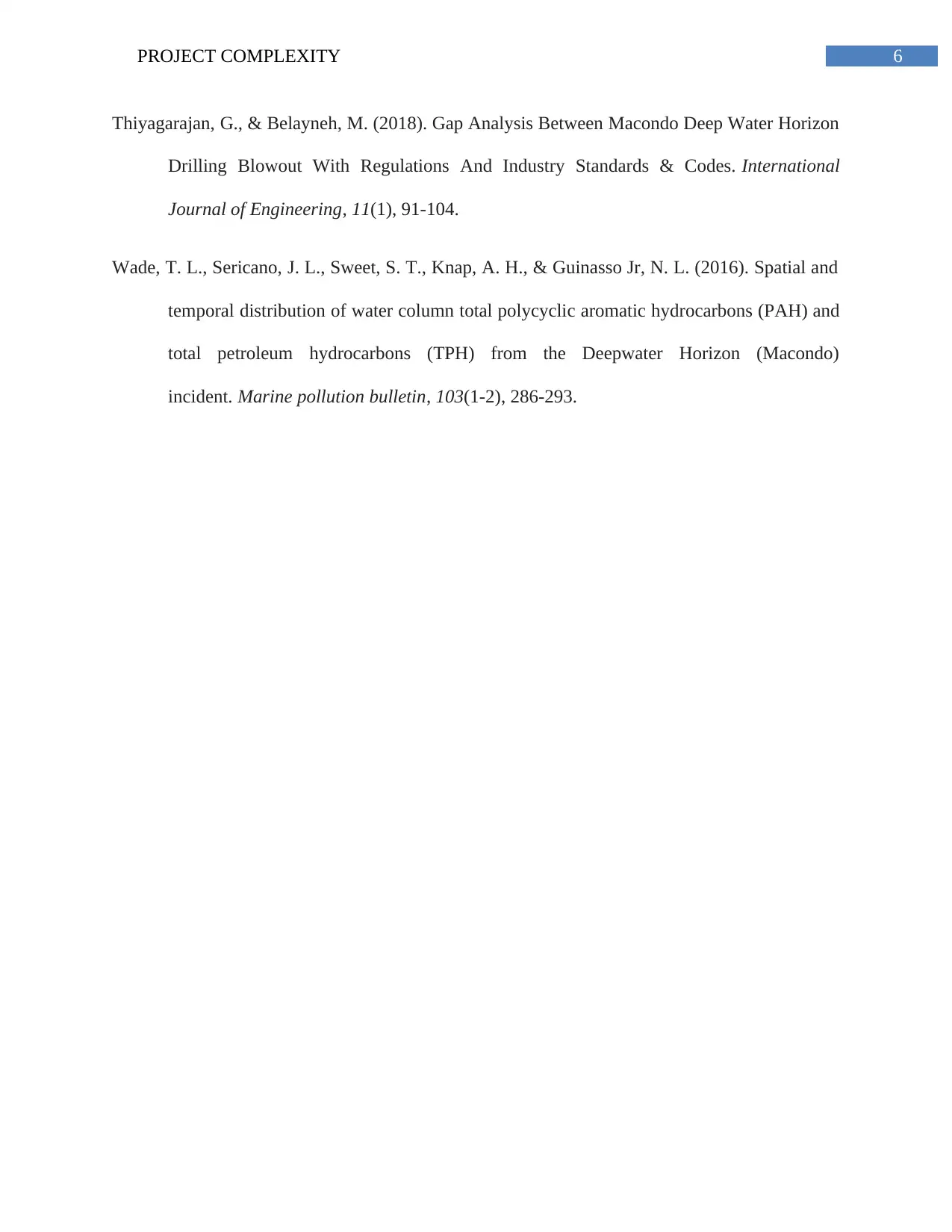
6PROJECT COMPLEXITY
Thiyagarajan, G., & Belayneh, M. (2018). Gap Analysis Between Macondo Deep Water Horizon
Drilling Blowout With Regulations And Industry Standards & Codes. International
Journal of Engineering, 11(1), 91-104.
Wade, T. L., Sericano, J. L., Sweet, S. T., Knap, A. H., & Guinasso Jr, N. L. (2016). Spatial and
temporal distribution of water column total polycyclic aromatic hydrocarbons (PAH) and
total petroleum hydrocarbons (TPH) from the Deepwater Horizon (Macondo)
incident. Marine pollution bulletin, 103(1-2), 286-293.
Thiyagarajan, G., & Belayneh, M. (2018). Gap Analysis Between Macondo Deep Water Horizon
Drilling Blowout With Regulations And Industry Standards & Codes. International
Journal of Engineering, 11(1), 91-104.
Wade, T. L., Sericano, J. L., Sweet, S. T., Knap, A. H., & Guinasso Jr, N. L. (2016). Spatial and
temporal distribution of water column total polycyclic aromatic hydrocarbons (PAH) and
total petroleum hydrocarbons (TPH) from the Deepwater Horizon (Macondo)
incident. Marine pollution bulletin, 103(1-2), 286-293.
1 out of 7
Related Documents
Your All-in-One AI-Powered Toolkit for Academic Success.
+13062052269
info@desklib.com
Available 24*7 on WhatsApp / Email
![[object Object]](/_next/static/media/star-bottom.7253800d.svg)
Unlock your academic potential
Copyright © 2020–2025 A2Z Services. All Rights Reserved. Developed and managed by ZUCOL.




